17 Best Climbing Backpacks of 2024
Gone are the days when climbing consisted of floating crampons, spiked boots and a week of cross-country trekking on sections of granite. Current trends in mountaineering gear focus on functionality, performance and smart design, and backpacks have followed suit. In this article we will divide the best climbing backpacks of 2024 into three categories: rock, trail and mountaineering. Each bag fills a different need, but all focus on organization (both inside and out) and are generally lightweight and durable. For more general information, see our climbing bag comparison chart and purchasing tips in the Selections section.
Best Overall Climbing Backpack
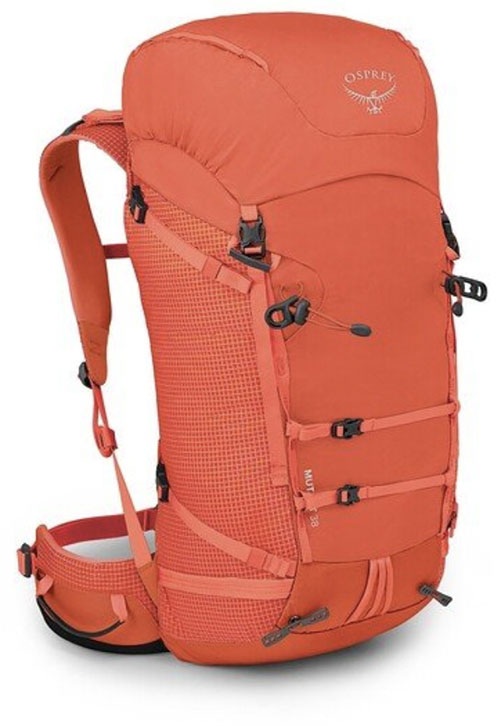
1. Osprey Mutant 38
Category: Mountaineering/Climbing
Weight: 2lbs 8.3oz.
Volume: 22, 38, 52 l.
What we like: Handles heavy loads well; Very versatile.
What we don’t like: It’s heavier than most travel backpacks, and the hip belt isn’t removable.
Truth be told, we never thought we’d see the Osprey brand (a favorite among hikers and backpackers) on the top of a mountaineering product, but we’d be right to be wrong. The Mutant for Mountains is an excellent mountaineering backpack that combines absolute comfort with numerous technical features and a customizable design. It’s an all-weather backpack suitable for any challenge, be it ice climbing, mountaineering, rock climbing, multi-climbing or even skiing, and with the latest update it now offers even more grip and durability. Environmentally friendly materials. It’s worth taking a closer look at this unique marvel, which offers much greater ease of use than most modern alpine backpacks.
The Mutant 38 is a good choice if your idea of climbing includes multi pitch routes or mountains in addition to rock. But not all climbers need such a versatile design: most sport climbers will prefer a backpack-style bag like the Creek 50 Below, while lighter, faster climbers will want to save weight with a simple design. (Like the Arc’teryx Alpha FL or the Mountain Hardwear Alpine Light below.) Also check out the 52-liter Mutant engine, which provides more power for commercial or night-time applications. Regardless of capacity (it’s also available as a 22-liter backpack), the Osprey offers a great combination of comfort and convenience for a variety of climbing styles.
best backpack for climbing
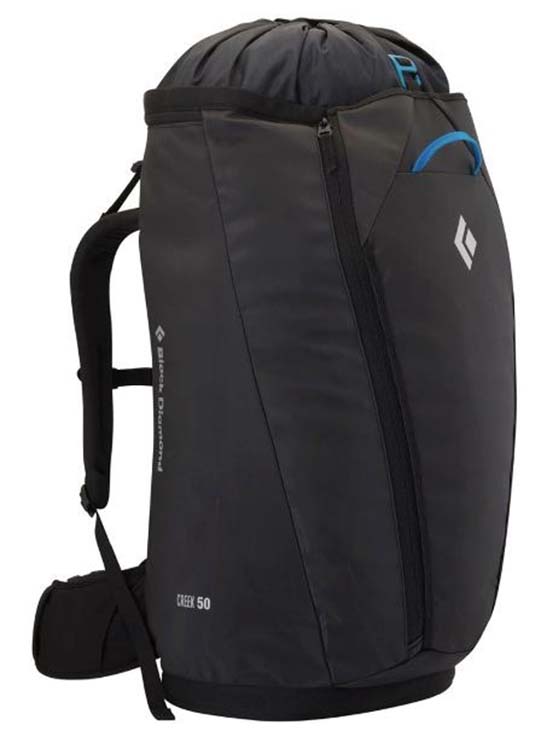
2. Black diamond wire 50
Category: pineapple
Weight: 4lbs 7oz.
Capacity: 35.50 litres
What we like: Easy to carry and incredibly durable.
What we don’t know: The cavernous chamber may resemble a black hole.
If you’re an avid climber, you probably spend more time on rocks than on longer routes or in the mountains. And while any old backpack will do for traveling with sports or traditional gear, Black Diamond’s workhorse Creek 50 is our pick for the job. With a flat bottom for vertical loading and unloading, convenient pockets, side zipper access to the main compartment, and the most durable 1200-denier polyester fabric available, it’s the perfect everyday gear. Broken among the rocks.
The Creek 50 is one of the most durable and well-designed rock sets, but unless you always have a huge commercial rack with you, its 50-quart capacity may be too large. Black Diamond also makes the Crag 40: a lightweight, streamlined version of the Creek that costs half the price ($100) but is, in our opinion, half the bag (its fabric is much less durable). On the other hand, backpacks like the Patagonia Cragsmith pictured below provide easy access to your gear, but a simpler backpack is easier to carry and has fewer breakable parts (we’ve been using ours for almost a decade and it’s still in use) . . ). ). strong). Overall, the Creek 50 is a backpacker standard and worth its $220 price.
Best Follower Pack for Multi-Pitch Climbing
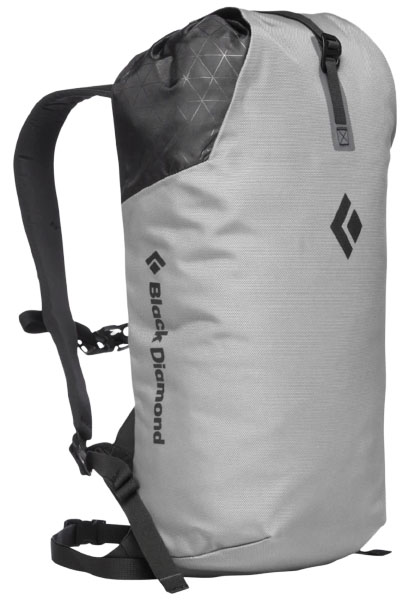
3. Black Diamond Stone Explosion 15
Category: Luxury
Weight: 14.2 oz.
Capacity: 15 litres
What we like: Very durable shape and ideal for challenging climbs.
What it’s not: More expensive and heavier than the REI flash shown below.
The Black Diamond Rock Blitz is a backpack specifically designed for climbers, ideal for carrying enough supplies for a day on longer routes in places like Red Rock or Squamish. You get incredibly durable materials that can withstand anything you throw at the road (including stoves), plus a foam-lined back panel and shoulder straps to keep you comfortable. The Rock Blitz is spherical and sits high on your back, close to your body and away from the harness, allowing you to lift yourself up unhindered. And during a meeting, you can access all your snacks and condiments through the top opening, which closes with a one-handed drawstring, or through the small zippered side pocket.
Made from durable 840 denier nylon, the Rock Blitz offers big durability in a small package. Sure, it doesn’t stand up to the test of a carry-on (especially if you tag your bag on the road), but it holds up much better than most fan backpacks, like the cheaper REI Flash featured below. Plus, at 14.2 ounces, it’s shaped enough to fit into a larger backpack, and you can also remove the hip belt and sternum strap to reduce excess weight. As of this writing, the Rock Blitz is sold out, but Black Diamond also offers the Blitz Alpine backpack, available in two sizes (20 and 28 liters) and made with a thinner, lighter 100-denier fabric. Snow bindings and removable foam back panel.
Best Ultralight Alpine Climbing Backpack
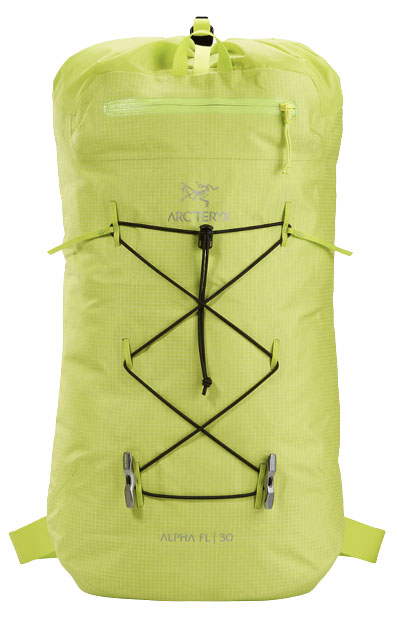
4. Arcitrix Alpha FL 30
Category: Alpine
Weight: 1 pound 6 ounces.
Capacity: 30, 40 litres
What we like: Great durability, comfort and water resistance in a simple package.
What we don’t do: We don’t compromise fit and we don’t just sell in one size.
To create the lightweight Alpha FL, Arc’teryx combined the design of a flapless, top-loading hiking backpack with a durable, medium-capacity bag. This backpack is a climber’s dream: it’s stylish, lightweight, holds its shape, is waterproof and is highly abrasion resistant thanks to the 400 denier ripstop fabric. To accommodate climbers’ diverse storage needs, the Alpha FL expands to 37 liters on approach and folds down to a 30-liter (or smaller) jetpack-like format when technical issues arise. Plus, accessing the contents is easy, too, with gloves, tie-down points, bungee ties, and a top strap that lets you secure everything from the rope and straps to the sleeping pad and extra layers on the outside.
Given the recent update to the Alpha FL line, the ’30’ here is very similar to the old ’45’, which held 32 liters in the main bag and 45 liters with the collar extended. Other changes include a larger front pocket, an additional internal pocket and modified shoulder straps. But many of the previous model’s flaws remain, including a thin profile that doesn’t accommodate bulky items, a thin waistband (i.e., little support), and a minimalist look with very few organizational options. Unfortunately, the Alpha FL is only available in one size, which can be a limitation for those with particularly small or large frames. But despite these compromises, the Alpha FL is one of the most capable and well-designed models for mountain use.
Best Work-to-Gym Climbing Pack
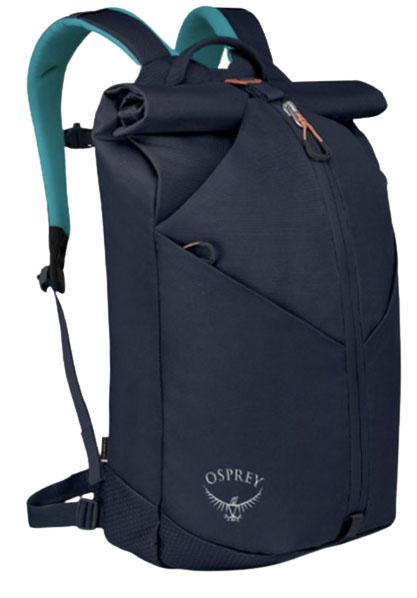
5. Osprey Zealot 30
Category: Gym/School
Weight: 1 pound 15.4 ounces.
Capacity: 30.45 litres
What we like: Two compartments share chalk supplies.
What we don’t like: Not big enough to hold the rope.
There’s nothing like climbing outdoors on real rocks, but the gym is a great resource when you’re stuck in the city. And while any old backpack will do, Osprey’s new Zealot 30 is designed specifically to take you from work to the gym. The best feature of this backpack is its organization: Two compartments keep your chalky (and smelly) climbing gear separate from things like your laptop, water tank, or food. The climbing gear pocket is accessed via a long front zipper, while the top zipper opens both compartments (the back one can accommodate a laptop bag or gym bag) and expands to accommodate larger loads. This is a great solution for the modern climber.
As mentioned above, Osprey knows how to make a durable backpack; Everything else about the Zealot is excellent and well thought out, including two external pockets (one zippered), an internal carabiner pocket, and a bike light holder. It’s also built to withstand everyday abuse, including wet road trips, thanks to thick 840-denier ballistic nylon treated with a durable water-repellent coating. Finally, if you spend a lot of time at the climbing gym, the Zealot 30 is worth a look (you can find a cheaper, less equipped option in the Black Diamond Bullet below).
Best of the Rest

6. Patagonia Cragsmith 45L
Category: pineapple
Weight: 3lbs 12oz.
Volume: 32.45 litres.
What we like: Durable and well organized.
What we don’t like: Turning off a device when it’s fully charged can be tricky.
Patagonia calls the latest iteration of its rock collection a “dump,” and we think that’s an appropriate term. The Cragsmith U-Zip allows easy access to all pack contents without exposing your gear (or the pack’s suspension system) to dirt. It is also covered with a small layer of foam which supports the structure and facilitates loading and unloading. Made from 630 denier fabric, the Cragsmith is a durable, well-designed everyday tool that will protect your gear in most conditions.
For proper use, the Cragsmith 45L is almost perfect: comfortable, stylish, durable and safe enough to use as a carry bag. But while Cragsmith is one of our most sustainable options, it comes with its fair share of trade-offs. Compared to top-loading backpacks like the BD Creek 50, Patagonia’s offering isn’t as user-friendly. You can’t accidentally throw too much gear into the Cragsmith and we often saw friends struggling to close the top zip with heavy loads. But when it comes to sport climbing, or when you’re sharing a rope and standing between two people, Cragsmith is one of our favorite rock bands.
7. Mountain Hardwear Alpine Light 35
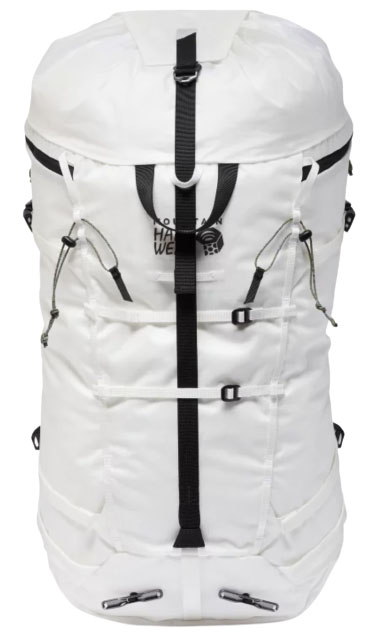
Category: Mountaineering/Climbing
Weight: 2lbs 2oz.
Capacity: 28, 35, 50 litres.
What we like: Incredibly comfortable and practical for such an elegant design.
What we don’t like: Expensive.
If there’s one backpack in our arsenal that we need more than any other, it’s the Mountain Hardwear Alpine Light 35. For us, this design represents the perfect balance between simplicity and functionality: two side pockets and zippers are a great alternative to a bulky flap. . . The carrying system is simple but practical, and the external attachment points do their job (for skis, snow tools and crampons) without getting in the way when not in use. Additionally, we found that the pack holds up better than most entry-level alpine models (thanks to the aluminum frame and foam layer), and the ripstop nylon fabric is incredibly durable and stylish.
8. REI Co-op Flash 18
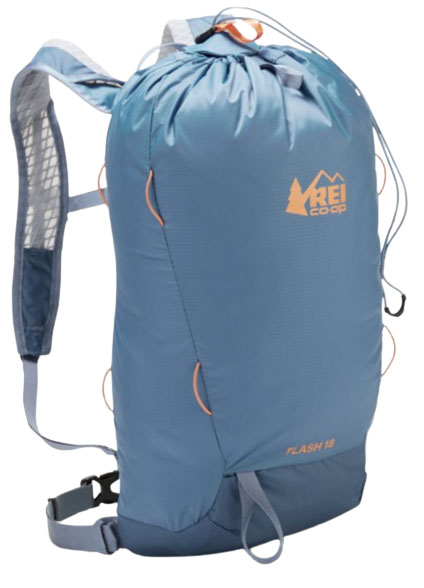
Category: Follow
Weight: 9.5 oz.
Volume: 18.22 l.
What we like: Lightweight and affordable, with a wide range of practical features.
What we don’t like: Thinner and less durable than competing products.
We know what you’re thinking: Ray? Mountaineering bag? Answer: yes. » Indeed, the Flash 18 is the lightest and most expensive model on our list, but it still offers many useful features. Like many other backpacks, the Flash 18 has a drawstring. The top can be opened and closed with one hand, the back panel can be removed and used as a seat cushion, removable hip and sternum straps and even leash points, as well as an ice ax loop. For $40 and only 9.5 ounces, this is a huge package.
But despite its impressive weight and price, the Flash 18 has its drawbacks, especially in terms of durability. The thin nylon design pales in comparison to more durable fans like the Rock Blitz above. They are not designed to be towed on the road, will not last long in chimneys, and may break if you load them with sharp climbing gear on the way out. But for $40, Flash certainly offers great value for money, and its capabilities are surprisingly efficient when it comes to scalability. For those looking to trade a little more space for a little more storage, REI also offers the Flash 22 ($60; 14 ounces), which adds 4 liters of capacity and includes elastic pockets on each side and a practical top with zip. . Bedroom.
9. Mountain Hardwear Scrambler 25

Category: Trekking/Mountaineering
Weight: 1 pound 14 ounces.
Capacity: 25, 35 litres
What we like: Versatility as a focus group or affiliate package; A set of features.
What we don’t like: It’s not very durable and the roll cage limits strength.
The Scrambler 25 from Mountain Hardwear is an attractive and versatile backpack for mountain climbers. Adding a little more weight than other bags of the same size, you get a ton of features, including a removable floating flap, an internal gear loop, and fairly streamlined side pockets that sit high on the torso. The result is a backpack that offers comfort on the road and also handles climbing well. For approaches and climbs like Red Rock, Yosemite or even Bugaboos (the Scrambler has mountain-specific features like a snow guard and seat-mounted windshield), Mountain Hardwear is flat, versatile and efficient.
The Scrambler is also available in a 35-litre version, which can accommodate more gears but is less practical on the road. However, with a similar hip belt to the 25, don’t expect much comfort on the trail, and both packs are heavier than the previous Alpine Light with 400 denier fabric (versus 200D). The Scrambler also doesn’t have the same durability as a Dyneema backpack like the Hyperlite below, even though it will cost you a lot less. For recreational mountaineers, multi-day hikers, or those looking for a bag that doubles as a backpack, we prefer the Scrambler’s combination of affordability and practicality.
10. Black diamond bullet 16

Category: Luxury
Weight: 1 lb 2 oz.
Capacity: 16 litres
What we like: Durable, versatile backpack for the gym, rock ‘n’ roll and everything in between.
What we don’t like: Not ideal as a dedicated subscription plan.
Look closely at any rock, climbing wall or spillway and you’re sure to see something from Black Diamond’s Bullet 16 collection. The Bullet has been around forever and is loved by climbers for its rugged construction, ease of entry and endless versatility. . Without a doubt: the prestige of the Black Diamond brand and its elegant appearance will never be underestimated. Mix up sneakers and chalk, pack them with a hydration pack and snacks for a quick cross-country hike, and use them to carry your laptop to the coffee shop; Whatever your climbing lifestyle, the Bullet is a great tool for the job. .
We like the Bullet because it’s a versatile bag that can be used as a travel bag or a lightweight climbing backpack. It’s incredibly durable thanks to 420D nylon (and 1260D reinforcements) and comes with a hip belt and foldable shoulder straps so you can take it with you wherever you go. But the reach isn’t ideal for a multi-step workout: With a belt, you risk losing the set if you remove it completely, and you can save weight by using a design like the Rock Blitz mentioned above. . Complaints aside, the Bullet is an incredibly versatile climbing pack that has proven itself over time.
11. Prisma Hyperlite 40
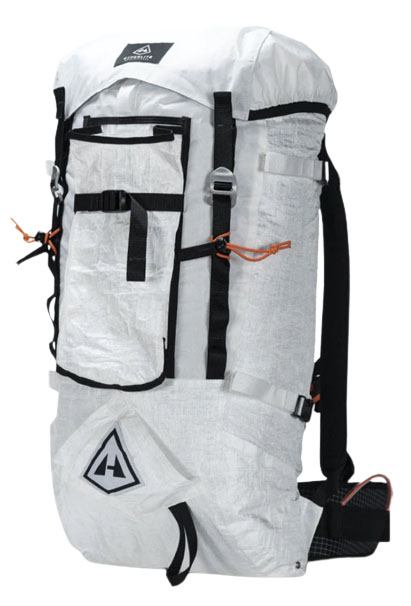
Category: Alpine
Weight: 1 pound 13.1 ounces.
Capacity: 40 litres
What we like: Lightweight and durable.
What we don’t like: The laces and fly have an outdated design.
Denim is one of the strongest fabrics in the world in terms of strength to weight ratio, it is extremely water resistant and extremely light. Suffice it to say, we generally trust backpacks that use these materials. The Prism 40 is the most reliable Alpine option in our range, even surpassing the previous Arc’teryx Alpha FL. It also compresses better than both, thanks to the top compression strap and side straps that adjust the load closer to your back, and it also has external load support, a feature mountain climbers and ice climbers will love. Plus, the aluminum back, durable foam padding, and padded waist strap make the Prisma more comfortable than a bag like the Alpha FL.
At $425, the Prism 40 is the most expensive model on this list and has some downsides. In particular, we found the laces and panels to have an outdated design, especially the Velcro closure on the tongue, making them difficult to remove if overcrowded. Most of the time, for quick and easy missions, we prefer the backpack without cover; You’ll simply have to deal with fewer moving parts every time you want to access your computer. Secondly, Dyneema is not breathable: if there is nothing between the fabric and your back to absorb moisture, you will sweat in the summer heat. But there’s no denying the Prizm’s durability, and its purpose-built design is hard to beat for climbers equipped with gear and crampons. Hyperlite also makes a less durable and slightly heavier Ice Pack 40 ($359), which has a flap closure, hip belt pockets, and an elastic closure.
12. Patagonia Ascensionist 35L
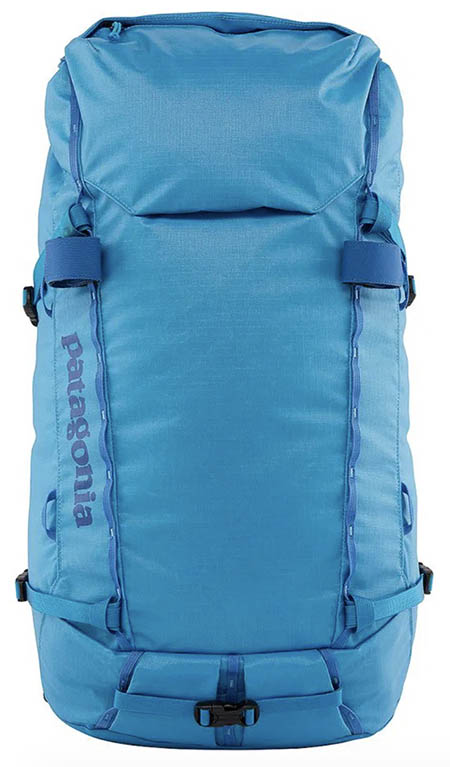
Category: Alpine
Weight: 1 pound 15 ounces.
Capacity: 35.55 litres
What we like: Lighter and stronger than the previous version, this is a great off-road model for multi-level climbs.
What we don’t like: Not as comfortable as the Osprey Mutant or as stylish as the Arc’teryx Alpha FL.
The Patagonia Ascensionist is designed for both approach and ascent, so it’s no surprise that the transition from one to the other is virtually seamless. When carrying a load on a hike, side and compression straps allow you to secure additional gear. Once you get to the top, insert the harness pads, adjust the bag well and you have a lightweight climbing shoe. During a meeting, the Ascensionist hangs from the rear carry handle and provides one-handed access to the main compartment or top zippered pocket.
The latest version of the Ascensionist features a lightweight yet durable design (the new version is the 420D versus the previous 210D model), rugged snow blower portability, and customizable features. One of our biggest complaints with the previous Ascensionist was the non-stretchy collar, which Patagonia has responded to with a high, weight-bearing collar in the new model. The result is an attractive SUV that looks like a streamlined version of our top-of-the-line Osprey but climbs better (though we still prefer the Alpha FL). For long stays in the mountains, the Ascensionist is also available in the 55 liter version, specially designed for daily transport.
13. Hide Arctrix 55
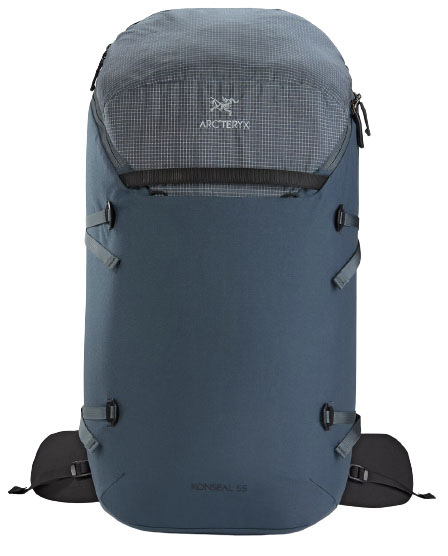
Category: Rocks
Weight: 3lbs 12oz.
Capacity: 15, 40, 55 litres.
What we like: The quilted design gives it a truly premium look.
What we don’t know: The organization isn’t as strict as rock bands Patagonia and Black Diamond.
Arc’teryx is known for making high-tech mountain gear, so it’s no surprise that its Rock backpack is made from high-quality materials, fits well, and has a shiny finish. The Konseal 55 is incredibly durable, with 690-denier nylon (and the same Hadron liquid crystal polymer mesh as the previous Alpha AR) and padded lining and sides to protect your gear and outer fabric. Like the Patagonia Cragsmith above, the Konseal 55 is also designed to be rack-mounted and features a large zippered top that folds away for easy access to your gear.
Almost everything Arc’teryx produces is high quality, but often very simple. May not be the same as accessing the front panel exit pocket. Great option from BD Creek. Plus, despite its rated capacity of 55 litres, our spacious Creek 50 can hold a lot of gear. But for those who love the Arc’teryx aesthetic, the Konseal is certainly well designed and offers great comfort. With a supportive suspension system (including aluminum frame and base plate) and two sizes for a custom fit.
14. Black Diamond Mission 55
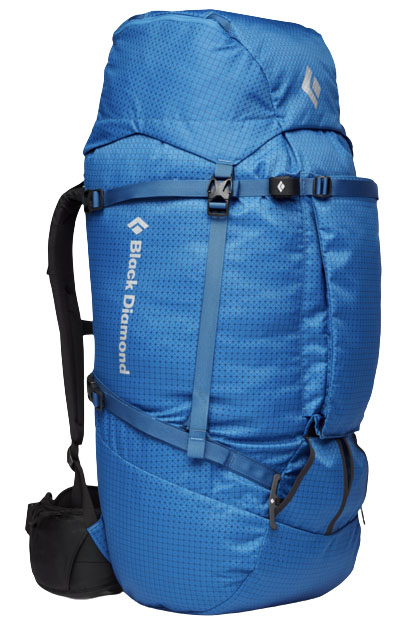
Category: Mountaineering
Weight: 3 pounds 15 ounces.
Capacity: 35, 45, 55, 75 litres
What we like: Comfortable, relatively affordable and durable.
What we don’t like: It’s not as lightweight or waterproof as other alpine backpacks.
A true all-in-one package, Black Diamond’s Mission includes all the features you need to perform all types of mountain stunts, including glacier climbing, bouldering, rock climbing, mountain climbing, and even skiing. You have a full-length side zipper for easy access to all your gear, and the removable design lets you remove the hood, hip belt (BD includes a mesh belt), and frame for maximum versatility: load it up backpack for comfort and aerodynamics. It is increasing. And in its latest update, the updated Mission features 420-denier X-rip nylon and welded rivets, making it stronger than ever.
What are the negative aspects of the Black Diamond 55 mission? At around 4 pounds, it’s definitely not the best choice for quick and easy activities, and since it doesn’t have a DWR coating, the fabric won’t keep your clothes dry in a storm like the Alpha FL and Prism above. Furthermore, there is no internal organization in the Taska: if you decide to remove the lid, nothing will stop you from storing the accessories. But these minor complaints aside, the Mission is an affordable backpack that might surprise you with its comfort, and it’s been around long enough to stand the test of time. We love this versatile and affordable backpack from BD as a great backpacking option.
15. CiloGear 3030 MOB WorkSack
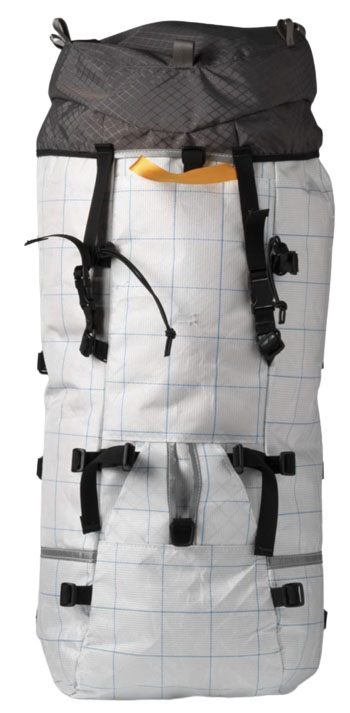
Category: Mountaineering
Weight: 2lbs 10.9oz. (1 pound 8.3 ounces peeled)
Capacity: 20, 30, 45, 60, 75 litres.
What we like: Extremely durable and thoughtfully designed for climbers.
What we don’t like: It’s not widely available and requires time and effort to set up.
If there’s anyone in the industry who cares about gasket materials and design, it’s CiloGear. This trendy Portland-based backpack brand designs and manufactures all of its backpacks in-house, creatively combining materials for maximum weight savings and durability. The end result is backpacks that are durable (we’ve tested them for over 10 years) and highly customizable: the bag, hip belt, compression straps and back panel/seat pad are all easy to remove and you can go back there. . . region. Then easily disassemble the backpack and transform it into a stylish climbing machine (patience required).
CiloGear WorkSacks range in size from 20 to 75 liters and each is designed to expand and contract to accommodate a variety of loads. The 3030 is our most versatile model and our favorite model for alpine missions: a 40-liter backpack with a 30-liter suspension system, meaning you can store your gear overnight and still be easy to carry when you are ready to ascension. Compared to the previous Alpha FL, it’s more customizable and better suited to heavy loads, but it lacks the waterproof fabric, aerodynamic design and ultra-light weight of the Arc’teryx. In terms of availability, CiloGear packages are usually sold at local hardware stores, but we’ve found their website to be the best place to purchase (again, patience required). Ultimately, these bags may not look as stylish as competing products, but they will last a long time and give you real mountain cred.
16. Black Diamond 40 Wall Mount

Category: Transport and mountaineering backpack
Weight: 4lbs 9.6oz.
Capacity: 35.70 litres
What we like: Exceptional durability and wall-mount functionality.
What we don’t like: Not the best carrying comfort and limited capacity.
This carrying case is unsurpassed in durability and endless performance. Originally designed to support large walls like Yosemite’s El Capitan, these bags are made of thick nylon and feature reinforced stitching, multiple carry points, hidden shoulder straps and removable waist straps. In short, they are very difficult to kill. Most tote bags are quite heavy, ranging from 70 to 100 litres, but we really like Black Diamond’s Wall Hauler 40, which offers plenty of durability for a day’s activities. Whether you need to mark walls all day or a reliable set for everyday use, the Wall Hauler 40 is a great tool for the job.
The Wall Hauler 40 is a huge improvement over Black Diamond’s Stubby, with ergonomic shoulder straps that greatly improve comfort. However, it still can’t compete with a backpack like the Creek 50 above, which has a padded back panel and a variety of sizes. It’s also worth bearing in mind that 40 liters might be a little too much, especially if you’re carrying a full roof rack and rope (again, the Creek 50 is better). But there’s nothing better for those hauling heavy, sharp equipment (like snow removal or road repair), and the Wall Hauler 40 is our top recommendation if you’re thinking about camping again.
17. Trango Pineapple Bouquet 2.0

Category: Peña
Weight: 3lbs 2oz.
Capacity: 45 litres
What we like: Affordable package with useful features.
What we don’t like: Not as well made as the Black Diamond Creek 50.
For those who need a large capacity bag, the Trango Crag Pack 2.0 packs a lot of features into a $120 package. A small removable tarp extends from the pack to keep your gear clean, a large external pocket fits comfortably while riding and an external mesh bag lets you store your sweaty climbing shoes. Additionally, the vertical taper design, similar to the Black Diamond Creek 50, allows for quick and easy loading and unloading of equipment. Thanks to the latest update, the Crag Pack now features a stronger 1000 denier fabric and also features a useful microfibre cell phone pocket.
Tips for buying climbing backpacks
Types of climbing backpacks
Do you really need a mountaineering backpack?
Weight
capacity
Consistency and durability
Easy transportation
Locking and access systems.
Pockets and organization
External gear accessory
Transport rings
Moisturizing compatibility
Update your plan
Types of climbing backpacks
Whether you’re taking a five-minute hike up a rock face, spending 48 hours climbing a tall granite tower in Patagonia, or enjoying a free climb with a day’s supplies, the right backpack can come in handy. Priceless. A big difference. difference. To help you, we’ve divided our favorite models into three categories: rock, trail and alpine.
Followers package
Support backpacks are designed to carry daily supplies (water, food, sunscreen, extra clothing, etc.) while traveling across the country. But buyer beware: the term “subscription package” can sometimes be used incorrectly. Most groups climb with a 16-30 liter backpack (carried by a guide), although on night or alpine routes the leader usually carries a small backpack. Others climbing long, extreme routes may prefer to carry a backpack rather than climb with a heavier load.
Alpine package
Alpine backpacks have a capacity of between 30 and 60 liters, and most climbers lean towards the smaller side to avoid extra weight and poor weight distribution. In general, when bringing a multi-day supply to base camp, leave approximately 30 liters for a one-day trip, 45 liters for an overnight trip, and 60 liters for a multi-day trip. Pay attention to payload limits as they are essential for on-road comfort. It’s surprisingly easy to load up an alpine backpack with rope, snow gear, crampons, and climbing helmet, but hiking with 40 pounds of gear in a pack that only holds 30 pounds will quickly become very tiring.
Haul Bag
I’d be remiss if I didn’t mention the bags here, which were originally (literally) designed to carry supplies up big walls like El Capitan in Yosemite. The bags are the most durable of the bunch, made from thick nylon and reinforced stitching for durability. They usually have a roomy compartment (organization isn’t their thing, but most climbers use a variety of bags to store their gear inside), multiple carry points, shoulder straps, and shoulder straps. Hidden and removable sides. Most cargo bags have a capacity of between 70 and 100 liters, but those designed for everyday use, like the Black Diamond Wall Hauler 40 above, hold around 40 liters of gear. We don’t recommend bringing bags to anyone planning a hike, but the truth is, you won’t find a more specific option for this.
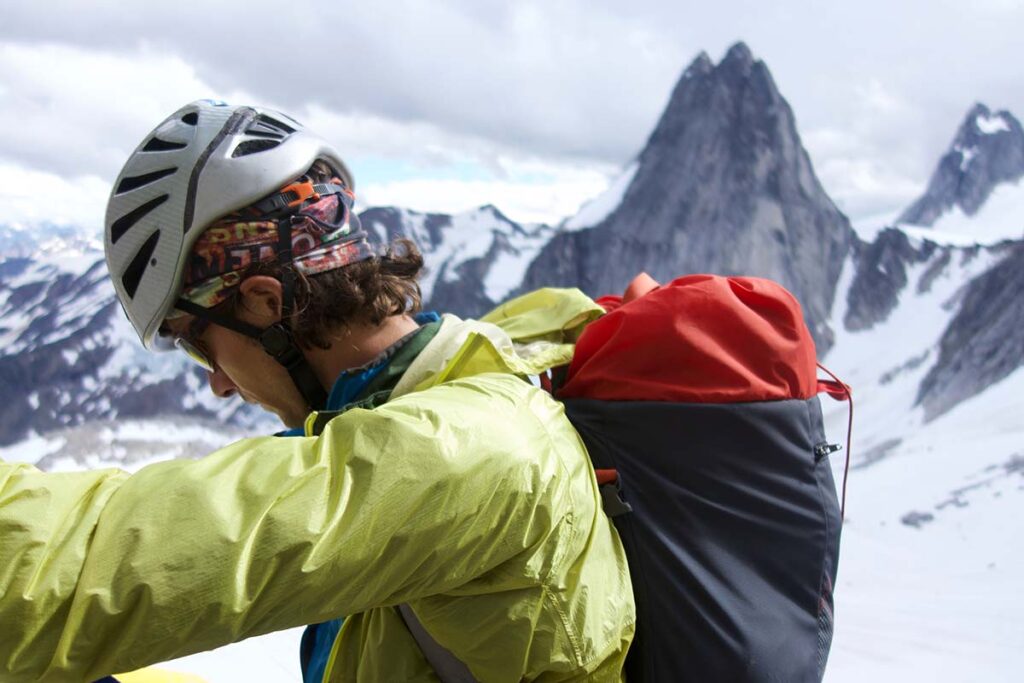
Do you really need a climbing backpack?
We see a lot of people using backpacks or backpacks for climbing, so we decided to directly answer the question: do you really need a climbing backpack? If you’re new to the sport or only play it a few times a year, the answer is no: save money, save the planet, and use what you already have. However, for passionate climbers, a climbing bag has many benefits.
While most packs aren’t designed to be thrown and dragged over rocks, most climbing packs are incredibly durable and should last season after season of use (our Black Diamond Creek 50 is in its tenth season and continues to be strong). ). They also have a simple frame with minimal straps and a simplified carrying system, which is what you need for short rock hikes or 5-10 minute mountain climbs. Finally, it’s hard to beat the features a mountaineering backpack has to offer, including secure carrying loops, convenient load organization, one-handed drawstring closure, and more. We’re big advocates of minimizing consumption, but if you spend a lot of time climbing, the answer is yes: a climbing backpack will serve you well.
Weight
When it comes to the gear you carry on your back, weight matters. However, climbing 2,000 feet (5.10) in one day is more disturbing than walking five minutes to the cliff. For this reason, hiking backpacks sacrifice some weight savings in favor of organizational features, comfort, and durability, while hiking and mountaineering backpacks eschew heavy fabrics, pockets, and suspension systems in favor of speed and lightweight . As always, keep in mind that weight loss requires sacrifice. If losing weight isn’t your top priority, you should consider options that are a little heavier, longer lasting, and more comfortable.
capacity
In general, the three categories above provide general capacity guidelines: partner backpacks range from 16 to 30 liters, rock backpacks range from 40 to 50 liters, rock backpacks range from 40 to 50 liters, and rock backpacks for mountaineering they range from 30 liters per mission. From one day to 60 litres. For a week. It’s important to think about what you plan to store in it: a backpack that’s too small won’t hold the gear you need, and a half-empty backpack is a waste of materials and likely won’t distribute the load evenly. . We like to think that a backpack is too big for a hiking bag, but we like our hiking bags to be quite full, even with gear attached. This is one of the reasons we really like the Arc’teryx Alpha FL 30: it’s a 30-liter backpack that can accommodate 37 people when needed.
Consistency and durability
Durability is always a consideration when it comes to outdoor gear, but it’s even more important when it comes to items that are constantly dragged over rocks and dropped on uneven surfaces. While some mountaineering backpacks are designed with durability in mind, others sacrifice blast protection to save weight. The materials each backpack is made of will help you decide whether it’ll fit your stuff: REI’s thin Flash 18 nylon, for example, makes it an obvious choice for a lightweight bag, but it breaks down quickly when carried over rough rocks. . . On the other hand, the Black Diamond Rock Blitz 15 is made of durable 840-denier nylon, which is great for portability, but it’s about 5 ounces heavier (and less compact) than the Flash.
Since rock climbing is generally a fair weather activity, most backpacks are not waterproof. However, mountaineers might benefit from a more protective backpack.
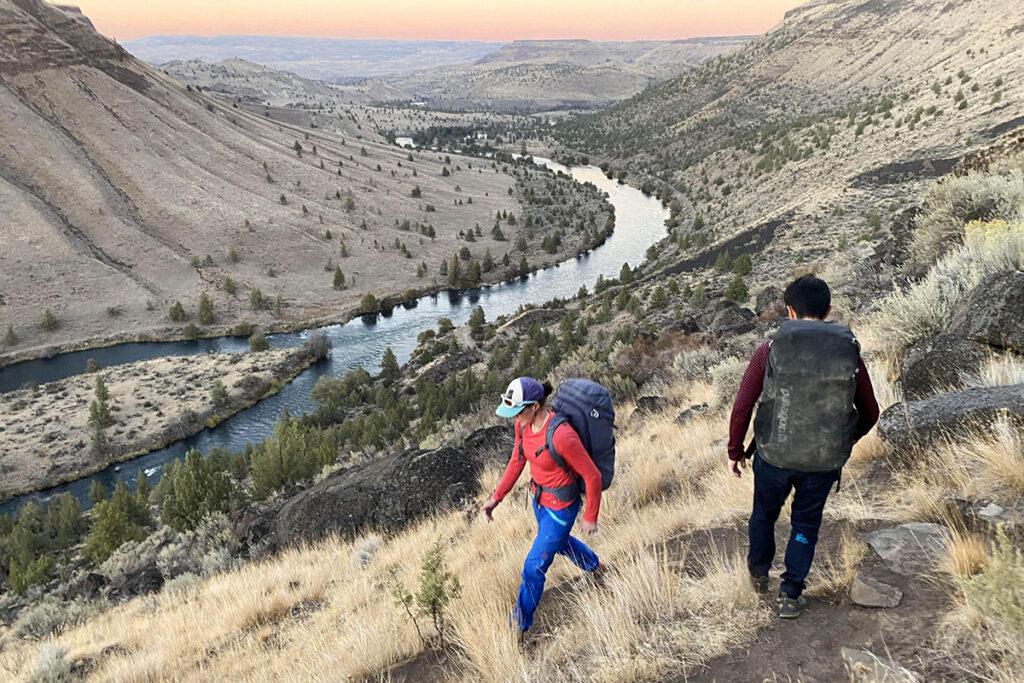
Easy transportation
The three types of backpacks also vary widely in terms of comfort. In most cases, with any backpack, you will want to place the load primarily on your hips rather than your shoulders. Cliff bags typically have padded hip straps, comfortable shoulder straps, and a comfortable back panel that can easily support a full load. You’ll increase in volume and weight when riding only short distances, and you’ll likely find that your load feels lighter thanks to the thicker suspension system. There’s really no reason not to relax in comfort.
On the other hand, many hiking and hiking backpacks forgo padding (especially on the hip belt and back panel) in favor of a thinner, lighter design. Some offer a higher level of comfort than others: for example, the Osprey Mutant 38 comes with seat belts and padded shoulder straps, while the Arc’teryx Alpha FL only has a simple harness. When it comes to hiking, many climbers prefer to carry a small set of guides on their back, away from their harness, rather than draping them around their waist. All of our mountaineering and running backpacks feature adjustable shoulder straps to accommodate a variety of sizes and carrying preferences.
Locking and access systems
The locking system on your backpack is a great way to find it. Is there a rope on his hand? It should be designed for quick and easy tasks where removing items from the backpack can be done quickly and easily. Do you have a zipper on the back? It seems that the Star Organization is lying. Removable lining with drawstring at the bottom? We thought it would be a great backpack to keep on hand and then detach for quick transport while traveling.
It is in the stone groups that we see the greatest diversity of evidence, which is not surprising. As mentioned above, comfort is important when playing rock music. Backpacks like the Patagonia Cragsmith and Black Diamond Stone 42 Duffel are similar to duffel bags, designed to provide easy, organized access to your gear. After all, we don’t need the convenience of an alpine backpack. In fact, when we are at anchor, we risk losing all our equipment when we try to open it.
Pockets and organization
Once again we will distinguish between the Cliff and Alpine/Slave packages. On the rock you will happily pay the price in terms of weight and volume for different sized pockets, loading and individual access. Choosing between top-loading backpacks, duffel bags, and U-boards often comes down to personal preference. Some rock backpacks come with a built-in canvas, while others have internal loops to organize your gear. Because the reach is shorter, you don’t need pockets on the hip belt like you would in an alpine pack (we’re thinking Patagonia Cragsmith).
When it comes to long approaches or ascents on foot, mountaineers are willing to make any logistical sacrifice to save weight and mass. Most mountaineering or hiking backpacks have a small internal or external zippered pocket. This may seem too small to be useful, but it isn’t. It’s much better to quickly access lights or accessories than rummage through a 10-gallon backpack during a meeting. However, be careful of zippered pockets on the body of the bag, like those on the Arc’teryx Alpha FL or the Mountain Hardwear Alpine Light 35. These pockets are very difficult to access when the bag is loaded and closed.
External gear accessory
Placing your gear on the outside of your pack can quickly go from organized to downright chaotic, so be careful what you put (and where). Climbers often carry a weighted backpack with them on the approach, and once the harness, climbing shoes, helmet, rope, stand and handles are removed, the bag does not become bulky or too large during the climb . This is why most hiking backpacks come with chains, straps, accessory straps, and snowplow mounts. Many hikers also have multiple anchor points for their gear, which is helpful if you’re hiking Squamish and descending to Chief’s Summit with all your gear. Our opinion is that you shouldn’t climb with a lot of gear in your backpack when traveling.
When it comes to rock backpacks, we highly recommend finding one that has an internal compartment to fit all your gear. The ability to fit everything into a backpack makes it quicker to load and more comfortable to carry. But if you have to hang a picture, no. 6 or camera on the outside, most Rock Pack backpacks come with external attachment points.
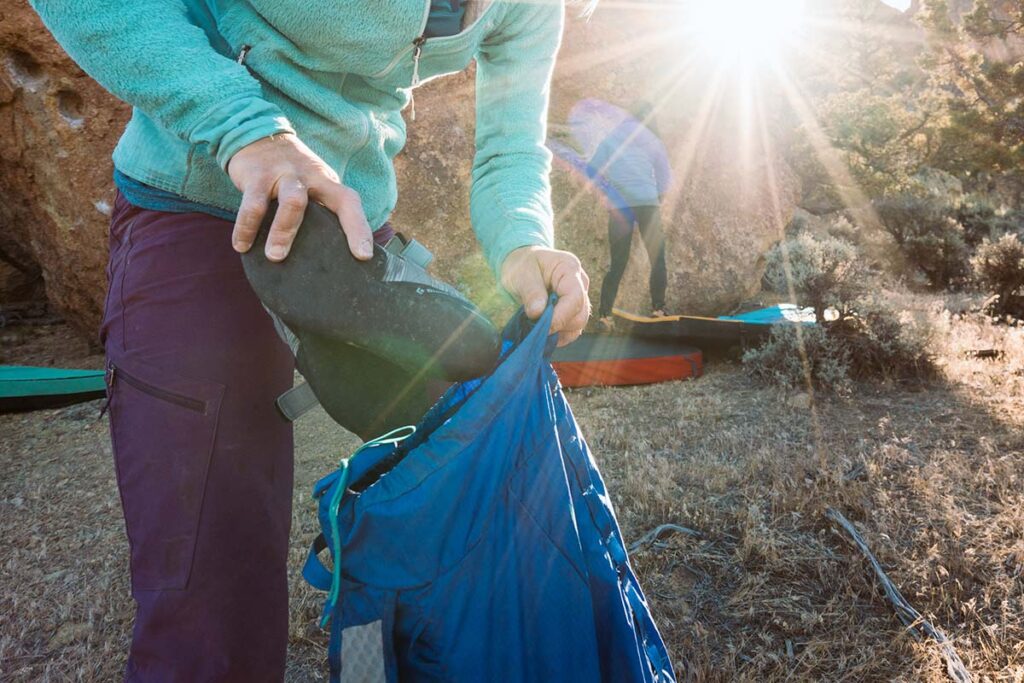
Transport rings
Whether you’re lifting the bag or tying it to an anchor, you need to make sure it has a strong attachment point. Many mountaineering backpacks are equipped with reinforced carrying handles for this purpose. The Wall Crawler Black Diamond outperforms the rest of our top picks in this department with large handles that easily attach to backpack contents, as well as two separate attachment points for added security. If your backpack only has one loop, especially if it’s not a carabiner (like the REI Flash 18), you’ll need to thread the carabiner through the loop and over the shoulder strap.
Hydration Compatibilityy
We haven’t talked much about water compatibility in this article, and for good reason. First, climbers probably won’t have to carry water during the short climb up the rock. Also, when it comes to hiking backpacks, we do not recommend hiking with the hydration reservoir tube hanging from the pack. They might scratch the stone or get in the way as you search for the next clue. As for mountain climbers, most climbers we know prefer not to load their backpack with liters of water during the approach, but rather attach a small 0.5 liter bottle to the outside of the backpack with a carabiner and fill it completely. Guide. day.
However, there are times when it is helpful to have constant access to water through a tank. In fact, most of the hiking and walking backpacks mentioned in this article are hydration resistant, with a few exceptions. But with bags on the shelves it’s a different story: none of our menus have a dedicated space.
Streamlining Your Pack
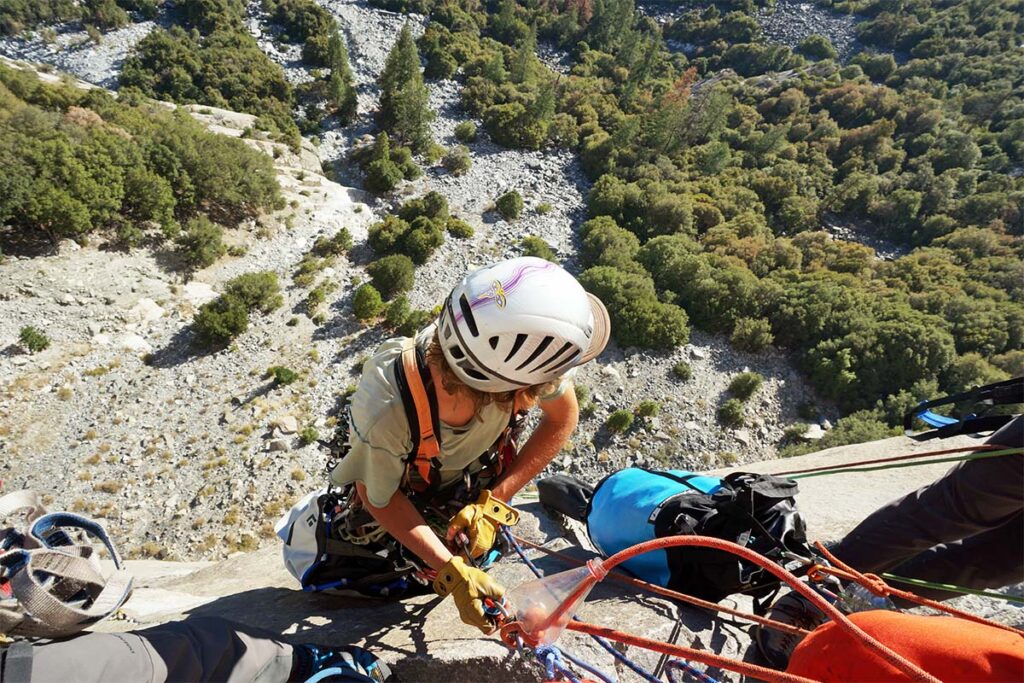
Many mountaineers, especially those heading into the mountains or on long hikes with multiple routes, will need a backpack that can help them shed unnecessary weight and bulk. Most alpine backpacks have features such as removable straps, flaps, hip straps, frame, webbing, etc. These components allow the backpack to hold more gear during the approach and therefore remain open during the ascent. Essentially, you want your alpine pack to look like a travel pack: one shoulder strap, no cover, and nothing more than a lightweight back panel/tent for shock absorption. Not only will it ride better, but it will also become lighter.

